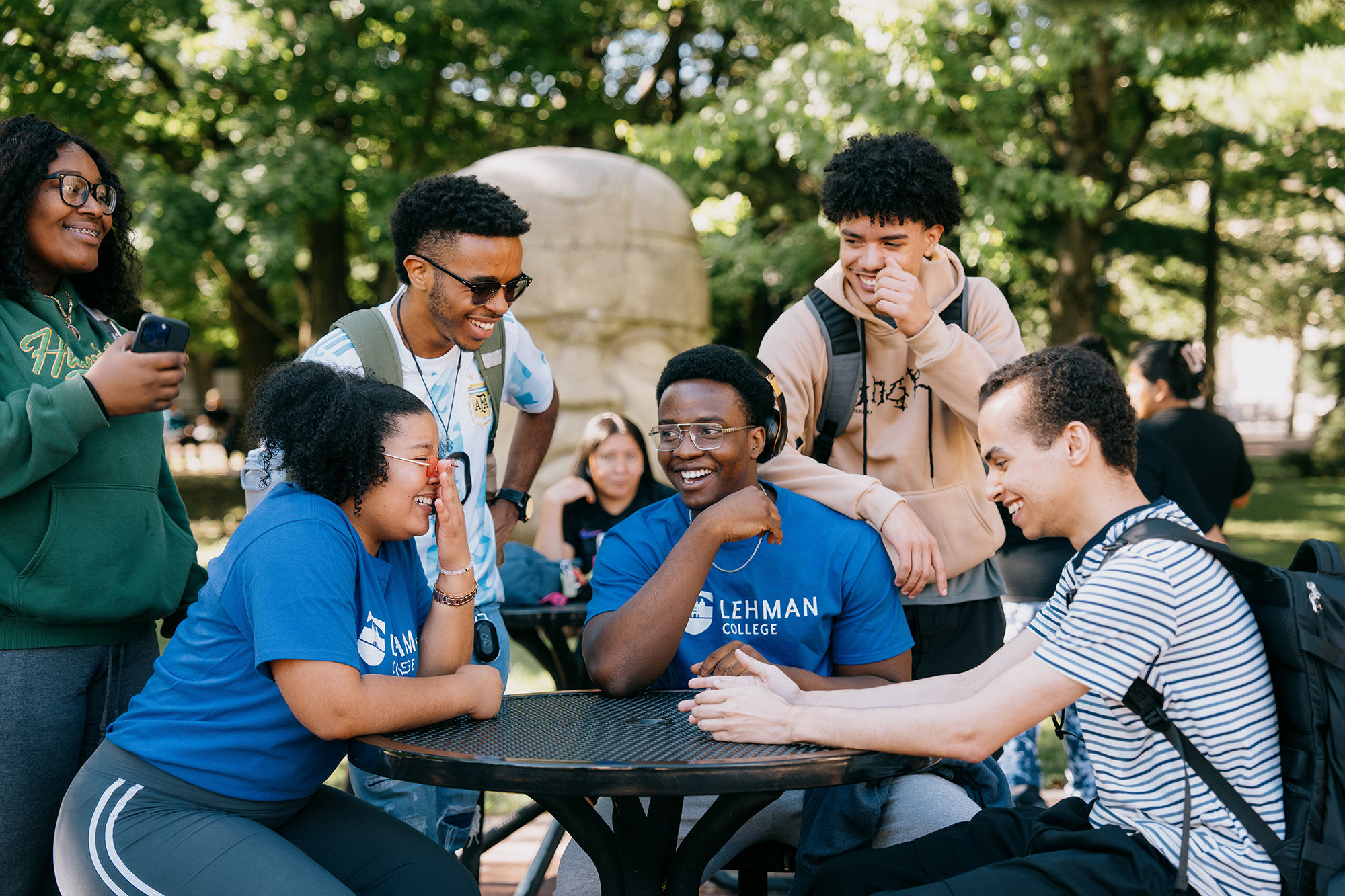Contacts
-
Center for Teaching and Learning
Email
718-960-2597
Leonard Lief Library, Room B05
RELATED LINKS
Academic Integrity FAQs
Here is a list of frequently asked questions regarding academic integrity and potential solutions on how to address your concerns/questions.
You can use a Blackboard announcement to refer to portions of the Definitions and examples of academic dishonesty from Lehman College Academic Integrity Policy, Undergraduate Catalogue, or make some of these guidelines into a credit/no credit quiz. There are many good resources, videos, quizzes, etc. available from academic institutions online regarding such aspects as paraphrasing, quoting, documentation. The Purdue OWL writing lab has a good collection of exercises that you can do or adapt as an activity you’re your students to raise their awareness of these issues.
Best Practice to Avoid Plagiarism. Purdue University's Online Writing Lab (OWL). Retrieved [Oct. 25, 2023].
Explain the principles behind academic integrity—providing evidence to support one’s statements and opinions; giving credit to others while indirectly demonstrating one’s own originality, powers of analysis, knowledge, skills; enabling others to better follow your arguments; and providing a valid basis to receive real feedback from the instructor, allowing one to improve; the advantage of having a degree from an institution with a reputation for outstanding student work and integrity.
Provide a statement in your syllabus, mention with every announcement or discussion of assignments due, encourage them to look at their own matches in Turnitin to see if any are out of line with guidelines, after assignments have been submitted and grades are in, remind them. Create a short quiz that is credit no credit on academic integrity rules and provide it before the first writing assignment or test is due.
Follow CUNY and Lehman policy and rules (CUNY Policy on Academic Integrity and Lehman College Academic Integrity Policy, Undergraduate Catalogue), but in marginal cases, give the benefit of the doubt, deduct enough points so as to get student attention to change behavior, or for extensively and obviously compromised work the first time this occurs, consider giving a choice between an F on the assignment or an opportunity to redo and resubmit.
Depending on the type of assignment, one can use a number of tools.
- For writing assignments, consider using TurnitIn within Blackboard. TurnitIn will try to identify matches to content in the paper, and you can then determine which are due to acceptably displayed quotations, citations, or other insignificant matches, and which appear to be copied from the internet or other sources. TurnItin also has its own feedback tools, and you can actually see if students have accessed your feedback.
- An oddly phrased or placed passage in a student paper that is not identified by TurnItin will sometimes show up by simply copying the phrase and searching for it in Google.
- To ensure a higher degree of test integrity, use the test-making features in Blackboard—create a large enough pool so that if you then randomize the questions, it will be less likely that two students will receive the same set of questions. Use features such as no backtracking or a timed test or even a password for access (which is only revealed to students in a short interval before the test).
- Acknowledge how your own habits may contribute to the problem. Whether writing assignments, quizzes, or other types of assignments, make an effort each semester to slightly revise your assignments, change your test questions or simply add more questions to the pool from which you draw your tests to prevent copying from semester to semester. This dishonest circulation of answers or the questions in advance can happen in on-campus classes but is often more easily done when everything is already in digital format.
- For group projects, ask students to make their drafts or initial work visible to you. This can be done within a group discussion board in Blackboard or a Blackboard wiki, or a recording in Zoom. Another method is to ask groups to keep a weekly log of progress on the project and who has contributed. This not only promotes academic integrity but also helps motivate students to contribute to the efforts of the group, as well as reassure them that you are aware of their individual efforts.
- In a smaller upper-division class, have students show their work in a presentation, and take questions from you and/or classmates on their work. It may also be appropriate in some cases to arrange for an oral exam or “debriefing” with a student via Zoom for a high stakes assignment or to have the student create an assignment presentation in VoiceThread. Provide questions that the student must answer that will indicate the student has a command over the knowledge and facts behind an assignment.
- For postings in discussion in which the response requires objective answers or higher stakes assignments posted in the discussion, consider using the feature “post first” which means students must post their own work before they can see the posts of others.
If you teach a hybrid class for which in-person attendance is required, then it is wise to reserve the in-person meeting for high-stakes tests or assignments. Be sure to prepare a version of the test for students who might miss and have to make up the test, or an alternative assessment. If students are taking a test online in a computer lab, in addition to walking about and monitoring the test session, you can consider using the Respondus tool (which features a lockdown of the internet browser) to discourage students from browsing for answers. CUNY policy states that the Respondus LockDown Browser may only be required if its use has been noted in the course description or syllabus. CUNY policy on using Respondus and information on Respondus for instructors can be found here, Instructor Guide to Respondus Lockdown Browser in Blackboard.
In the on-campus classroom, be sure to use traditional academic integrity methods in person like making sure all student electronic devices and books are stored out of reach, and that any blue books are brought empty to class (announce you will collect and re-distribute—have some additional empty blue books or paper on hand for those who don’t bring any). Remember that it’s important to revise your exam and assignment questions each semester.
For low-stakes quizzes (for example, each worth no more than 1-5% of the course final grade), use well-designed online quizzes, taking care to randomize and draw from a large pool. Or, depending on the goals for the quizzes (for example, to encourage students to carefully read more of the course content), try allowing multiple attempts (for example, 2 or 3 tries) with “open book,” encouraging students to look for the information, and awarding the grade to the best attempt.
It’s helpful to include more than just a single statement about Academic Integrity in your syllabus. Look for other opportunities to talk about issues related to academic integrity. Also, recognize that many students resort to using whatever is most easily found on the internet because they don’t really know what is available through the library or how to search and use its resources. Students could benefit from more encouragement, information, and specific examples about how to make the best use of library resources, and how to find and determine what are reliable, academic sources on the internet.
Don’t assume students understand when and how to properly cite sources or the finer points of what is considered copying or cheating. Typical points of confusion are the difference between citing within a text and compiling the list of references at the end, and correctly paraphrasing.
Some CUNY college libraries also have good resources for students on plagiarism, citation, paraphrasing, and related topics. You can select one that seems best suited for your class. Some examples to review are at:
- Rojas, A. (2022). Plagiarism Prevention Guide: What is Plagiarism? LaGuardia Community College Library. Retrieved [Oct. 25, 2023]
- Citation Style Guide: What is citation? Lehman College Library Research Guides. Retrieved [Oct. 25, 2023]
Two situations are that students might engage in informal study together outside of the class environment, or students might be officially assigned to work together in class groups to discuss or prepare assignments and projects. Clarify that appropriate informal study in groups includes sharing and exploring ideas, helping classmates better understand the course material, sometimes expanding and pooling research findings, or better preparing and studying before composing one’s own assignments or taking exams.
Explain that it does not involve sharing one’s actual assignment submission, collaborating on the final product of what is meant to be an individual submission or helping classmates find answers during the taking of an exam.
For assigned group projects, whenever feasible have students show their individual contributions by using a format that you can also see (blog, wiki, discussion board, group log recording work, etc.) or divide the final group grade into both a group and individual grade. This incentivizes students to want to demonstrate their own best efforts.
When they have delayed studying, missed classwork, or waited until the last minutes to start on an assignment, students are sometimes tempted to use shortcuts like copying or stitching together materials not their own, asking classmates to give them answers, etc.
Encourage students to log in frequently to a largely asynchronous online class, to make up missed work in a timely way (motivate them by increasing late deductions over time), and not to wait till the last minute to begin their work by creating an incremental step(s) for major assignments. For example, on a major research paper, have students first submit and receive a grade for an outline, or for compiling a reference list, a summary of their chosen topic, a preliminary draft, etc.
When appropriate, create one or more relatively low-stakes open book (but not open discussion) exam that allows 2-3 attempts, with the highest graded attempt as the score. The goal is actually to get students to review or more closely read the material. This not only reduces overall pressure on students but also provides an opportunity to give them feedback and make sure they are on the right path.
You can report Academic Integrity violations by submitting the following online form:
Lehman College Public Reporting Form
Violations may fall under one or more of the following categories:
- Plagiarism
- Cheating
- Internet Plagiarism
- Obtaining Unfair Advantage
- Falsification of Records and Official Documents
Details of each of these can be found at Lehman College Academic Integrity Policy, Undergraduate Catalogue.
Academic Integrity: Generative AI FAQs
Here are some frequently asked questions (FAQ's) regarding academic integrity and the use of Generative AI in your course(s). This will be an on-going list and will be updated as frequently as possible, in hopes to keep up with policies and best practices.
At this time, the acceptable use of Generative AI (if any) is to be determined by the instructor. CUNY is currently developing a policy to include the use of Generative AI in the policy for academic integrity. See the UFS Passes Academic Integrity Update for Artificial Intelligence.
Last Updated: 10/25/2023
When dealing with cases surrounding Academic Integrity, we refer to Lehman’s Academic Integrity Policy.
A faculty member who suspects that a student has committed a violation of the CUNY Academic Integrity Policy shall review with the student the facts and circumstances of the suspected violation whenever feasible. Thereafter, a faculty member who concludes that there has been an incident of academic dishonesty sufficient to affect the student's final course grade shall report such incident on a Faculty Report Form which is attached to this Policy and shall submit the Form to the college's Academic Integrity Officer who is:
Conrad I. Walker, Ph.D.
Assistant Vice President for Student Affairs and Dean of Students.
Office: Shuster Hall, RM 204
Phone: 718-960-8242
Email: conrad.walker@lehman.cuny.edu
You may have heard that Turnitin has a Generative AI detection feature. Due to inconsistencies with the tool, including false positives and other concerns, CUNY OAA has not activated this feature for CUNY. Some of the concerns are detailed in the article from the Washington Post.
Below, you will find some example language, from Bryant University, that you might consider adapting and including in your own syllabus:
EXAMPLE 1 – ALL USE
AI Writing tools such as ChatGPT are welcome in this class, provided that you cite when and how you use the tool. You will be provided with examples of how to cite your use of this tool in your writing.
EXAMPLE 2 – NO USE
AI Writing tools are not permitted for any stage or phase of work in this class. If you use these tools, your actions would be considered academically dishonest and a violation of *[Bryant's Academic Integrity Policy].
EXAMPLE 3A – SOME USE
During our class, we may use AI Writing tools such as ChatGPT. You will be informed as to when, where, and how these tools are permitted to be used, along with guidance for attribution. Any use outside of this permission constitutes a violation of *[Bryant's Academic Integrity Policy].
EXAMPLE 3B – SOME USE
We recognize that there are a variety of AI programs available to assist writers. AI programs are not a replacement for human creativity, originality, and critical thinking. Writing is a craft that you must develop over time to develop your own individual voice. However, within limited circumstances, and with proper attribution, AI programs may be used as a tool.
*Replace with information for Lehman's Academic Integrity Policy
You may have heard that Turnitin has a Generative AI detection feature. Due to inconsistencies with the tool, including false positives, general inconsistencies with the tool, as well as other concerns, CUNY OAA has not activated this feature across CUNY institutions.
To help put this reason into context, we have found this article detailing a student’s experience receiving a grade based on a false positive the Turnitin feature detected.
Here are a couple of suggestions based on research and best practices:
- The best measure to disincentivize students from using Generative AI is to have a syllabus policy/language. (see Generative AI Syllabus statement examples)
- A separate suggestion would be to have students “show their work”. Have students pass in various drafts and/or outlines they worked on (scaffolding the assignment). Or, have students submit a reflection on how they arrived at their final conclusions/thoughts. Some instructors share with us that they ask students to use Generative AI tool for their first draft, then turn on track changes and modify the “output” and submit that file.
- If you use tests/quizzes as assessment, you may want to create pools of questions and then have the system randomly choose X number of questions from the pool, you can prohibit backtracking, display one questions at a time, etc.
- Alternatively, for text responses, you can ask students to include a reference for each text response based on the course materials or other sources.
-
Center for Teaching and Learning
Email
718-960-2597
Leonard Lief Library, Room B05 - See all contacts







